Pressure VOLKSWAGEN GOLF PLUS 2012 Owner's Manual
[x] Cancel search | Manufacturer: VOLKSWAGEN, Model Year: 2012, Model line: GOLF PLUS, Model: VOLKSWAGEN GOLF PLUS 2012Pages: 541, PDF Size: 98.86 MB
Page 253 of 541
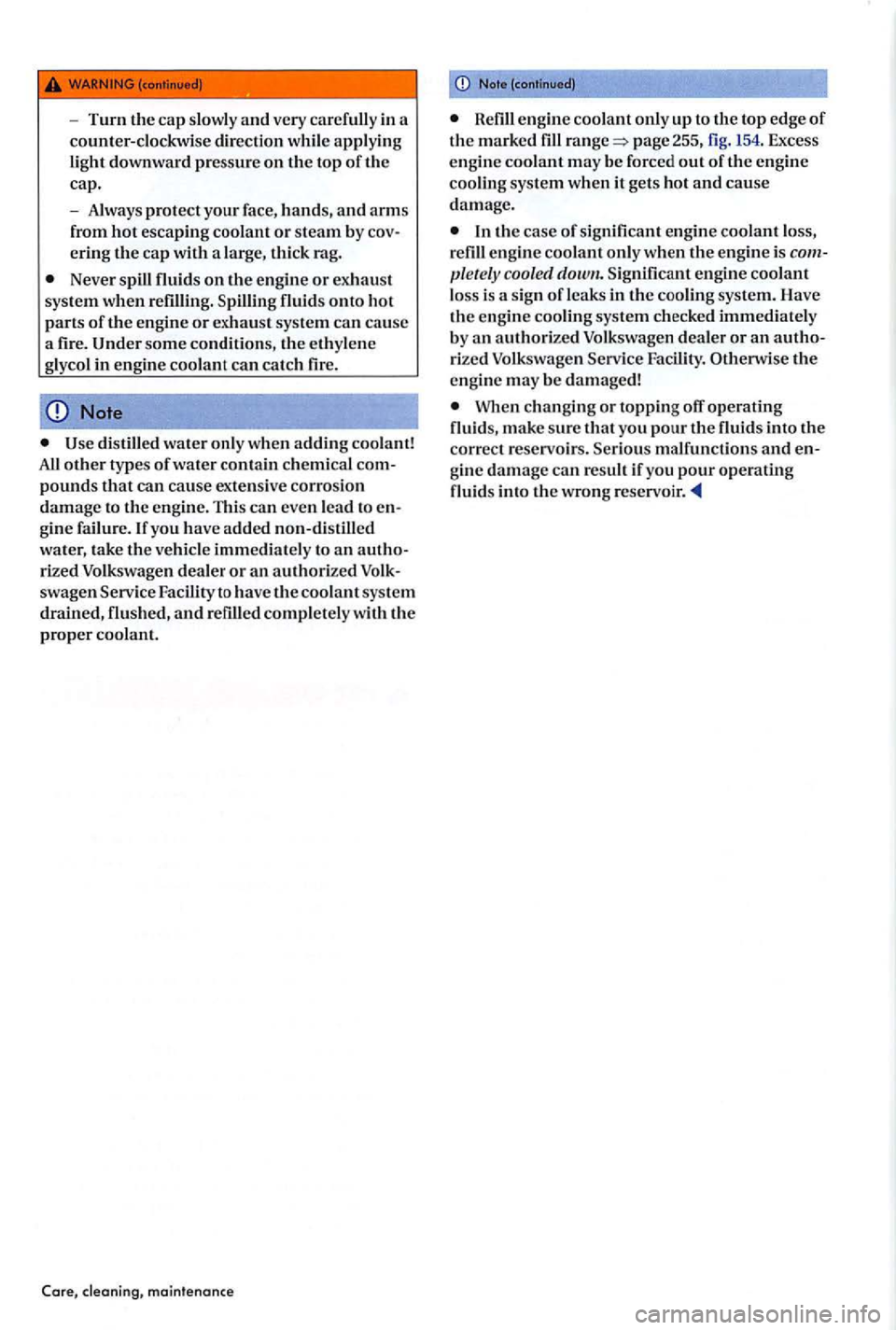
-Turn the cap slowly and ve ry ca re full y in a
counte r- clo ckwise dir ect.ion whil e appl yin g light downwa rd pressure o n the top of th e cap.
-
Always prot ect your face, h ands, an d a rms
f ro m hot escaping co olant o r steam b y ering the ca p with a la rge, thick ra g.
Never spill fluid s on th e e ng in e o r exhaust
sys te m when refi lling . fluid s ont o ho t
p ar ts of the e ng ine or exhaust syste m can cause a fire. some conditio ns, the eth yle ne
g lycol in en gin e cool an t catc h fir e.
Note
di still ed wa te r onl y when adding coo lant! All othe r types of wa te r contain ch e m ica l pounds that can ca use exte nsive cor rosio n
damag e to the e ngin e. Th is can eve n lead to
ri zed Volkswa ge n deale r or an authorize d to have th e coo lant sys te m
d rai ned , flu sh ed , and refille d compl ete ly w ith the
p ro per co olant.
m aintenance
Note (co ntinue d !
Refill eng in e cool ant only up to th e to p edge o f the m arke d fill range=> p age 255, fig. 154 . Excess
e ng in e coolan t m ay be forced out of th e e ng in e
co olin g sys te m when it ge ts ho t and cau se
d am age.
engi ne coo lant o nl y wh en the e ng in e is coole d Sig n ifica nt engin e cool ant loss is a s ig n of leak s in the cooling sys te m. Have
th e e ng in e coo ling syste m ch ecke d immedi ate ly
b y a n authorize d Volkswage n deale r or an ri ze d Volkswage n
When ch an gin g o r top pin g off ope ratin g
fluid s, make sure tha t yo u pour the fluid s int o th e
correc t reservoi rs. ma lfunctio n s and gine da m age can result if yo u p ou r operating fluid s int o the wro ng
Page 273 of 541
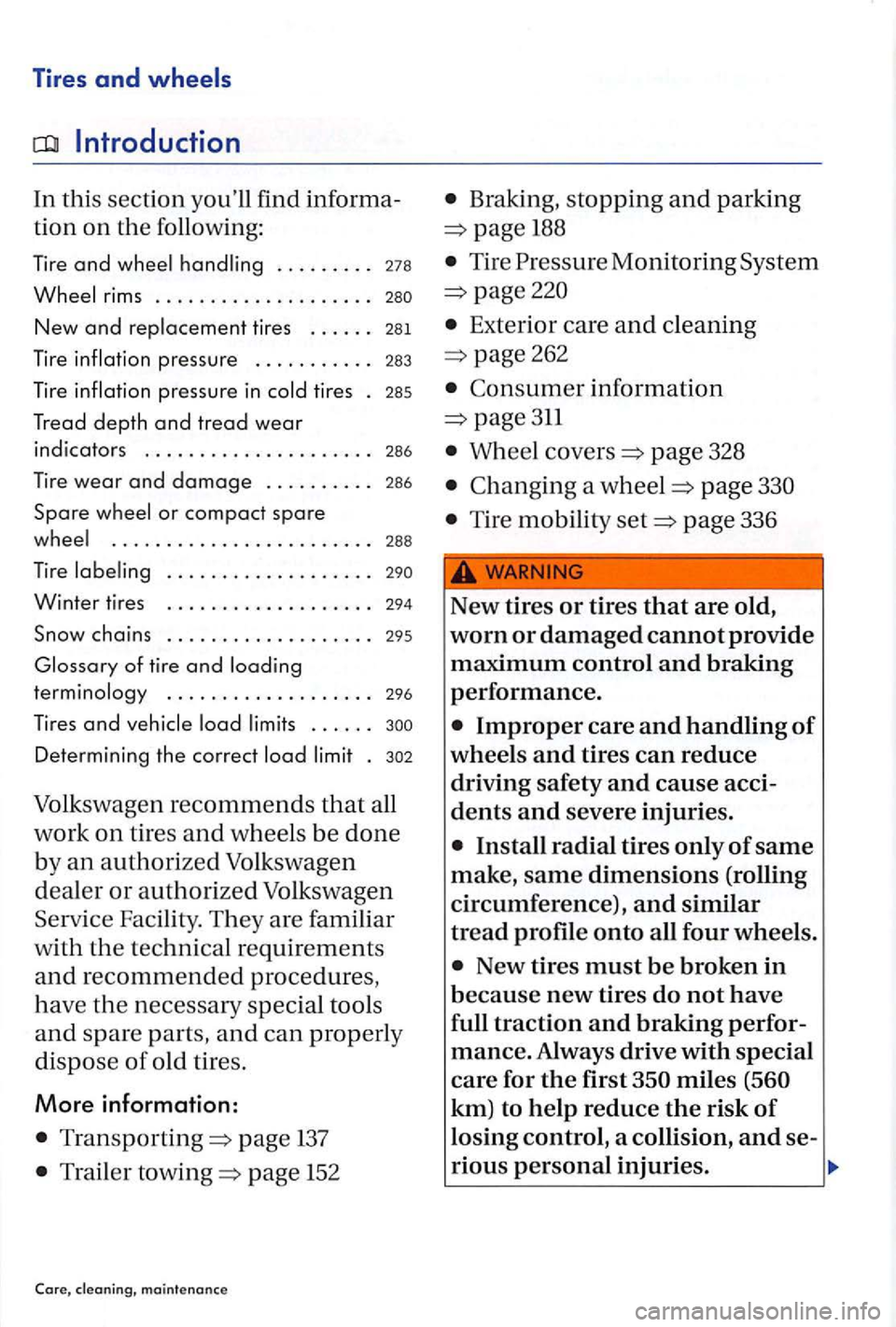
Tires and wheels
Introduction
In this section you'll find informa
tion on th e following:
Tire and . . . . . . . . . 278
New and tires . . . . . . 281
Tire
tires . 285
Tread depth and tread wear
indicators . . . . . . . . . . . . . . . . . . . . . 286
Tir e wear and damage . . . . . . . . . . 286
Spare or compact spare
....... ................. 288
Braking, stopping and parking
188
Tire Pressure Monitoring System
Exterior care and cleaning
page262
Consume r information
Wheel covers page 328
Changing a wheel page
T ir e mobili ty page 336
Tire ...................
Winter tires . . . . . . . . . . . . . . . . . . . 29 4
Snow chains . . . . . . . . . . . . . . . . . . . 295
of tire and
. . . . . . . . . . . . . . . . . . . 296
Tires and . . . . . .
Determi ning the correc t
page 137
Trailer towing page 152
Core, maintenance
New tires or tires that are old,
worn or damaged cannot provide
maximum control and braking
performance.
New tires must be broken in
because new tires do not have
full traction and braking perfor
mance. Always drive with special
care for the first
Page 274 of 541
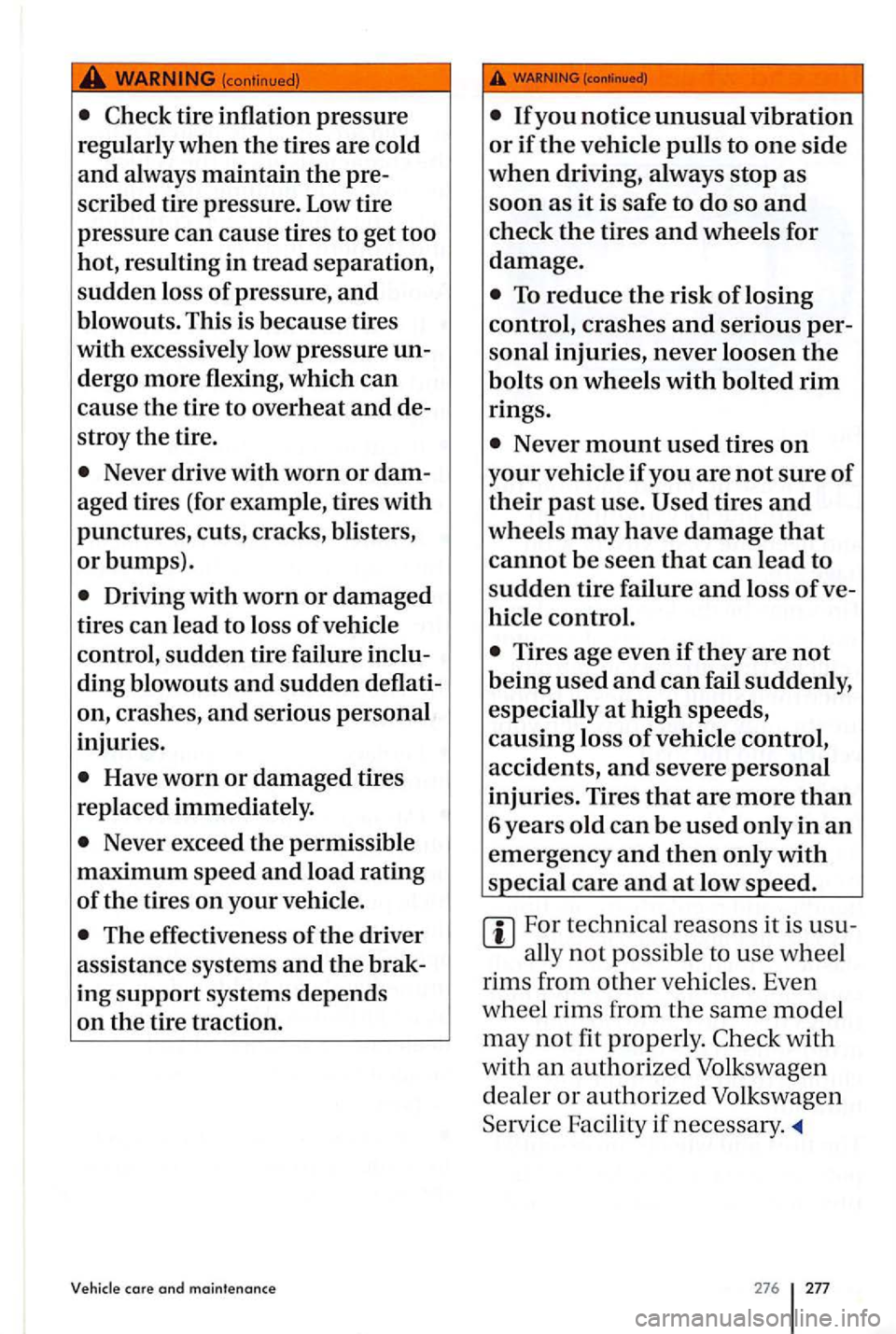
(contin ued )
tire inflation pressure
regularly when
the tires are cold
and always maintain the pre
scribed tire pressure .
Low tire
pressure
can cause tires to get too
hot, resulting in
tread separation,
sudden loss of pressure , and
blowouts . This is because tires
with excess ively low pressure
un
dergo more flexing, which can
cause the tire to overheat and de
stroy
the tire.
Never exceed the permissible
maximum speed
and load rating
of the tires on your vehicle.
The effectiveness of the driver
assistance systems
and the brak
ing
support systems depends
on the tire traction.
care and maintenance
To reduce the risk of losing
control,
crashes and serious per
sonal injuries, never loosen the
bolts on wheels with bolted rim
rings.
Never mount used tires on
your vehicle if you are not sure of
their past use.
Tires age even if they are not
being used and can fail suddenly,
especially
at high speeds,
causing loss of vehicle control,
accidents,
and severe personal
injuries. Tires that are more than
6 years old can be used only in an
emergency and then only with
special care and at low speed.
For technical reasons it is usu-
ally
not possible to use wheel
rims from other vehicles. Even
wh eel rims from
the same model
may not fit properly.
Fac ility if necessa1y.
276
Page 275 of 541
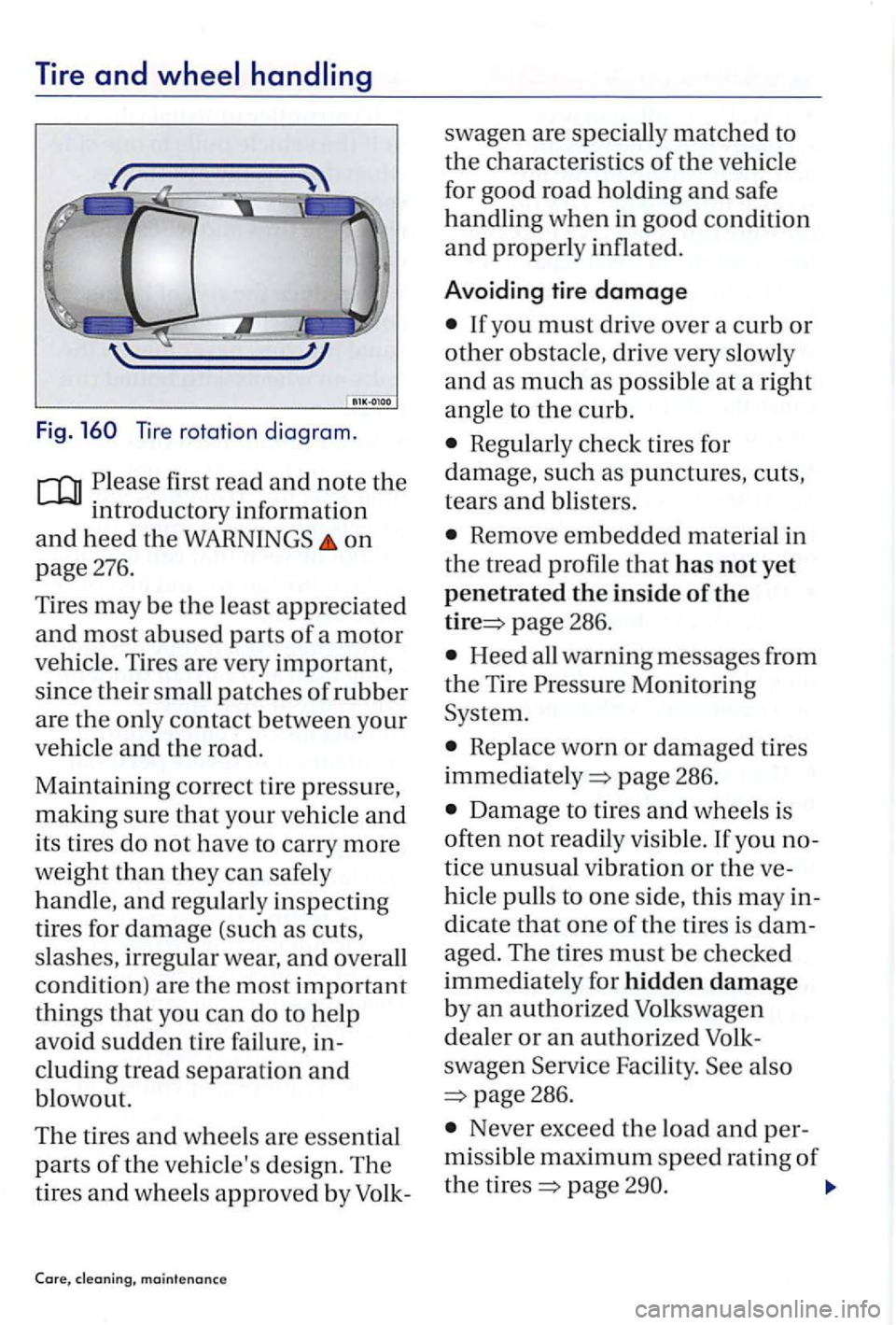
Tire and wheel handling
Fig. 160 Tire rotation diagram.
and note the
mtroductory mformation
and heed the WARNINGS on
page 276.
Tires may be the least appreciated
and most abused parts of a motor
vehicle. Tires are very important,
since their small patches of rubber
are the only contact between your
vehicle and the road.
Maintaining
correct tire pressure,
making sure that your vehicle and
its tires do not have to carry more
weight than they can safe ly
handle, and regularly inspecting
tires for damage (such as cuts,
s la sh es, irregular
wear, and overall
condition) are the
most important
things that you can do to help
avoid
sudden tire failure , in
cluding tread separation and
blowout.
The tires and wheels are essential
parts of the vehicl e's design. The
tires and wheels approved by Yolk-
If you must drive over a curb or
other obstacle, drive very slowly
and as much as possible at a right
angle to
the curb.
Regularly check tires for
damage,
such as punctures, cuts,
tears
and blisters .
Remove embedded material in
the tread profile that has not yet
penetrated the inside of the
page 286.
Heed all warning messages from
the Tir e
Rep lace worn or damaged tires
immediately=> page 286.
Damage to tires and wheels is
often not readily visible. If you no
tice unusual vibration or the ve
hicl e pulls
to one side, this may in
dicate
that one of the tires is dam
aged. The tires must be checked
immediate ly for hidden damage
by an authorized Volkswagen
dealer or an authorized Volk
swagen Service Facility.
Never exceed the load and per
missible maximum speed rating of
the tires=> page
Page 279 of 541
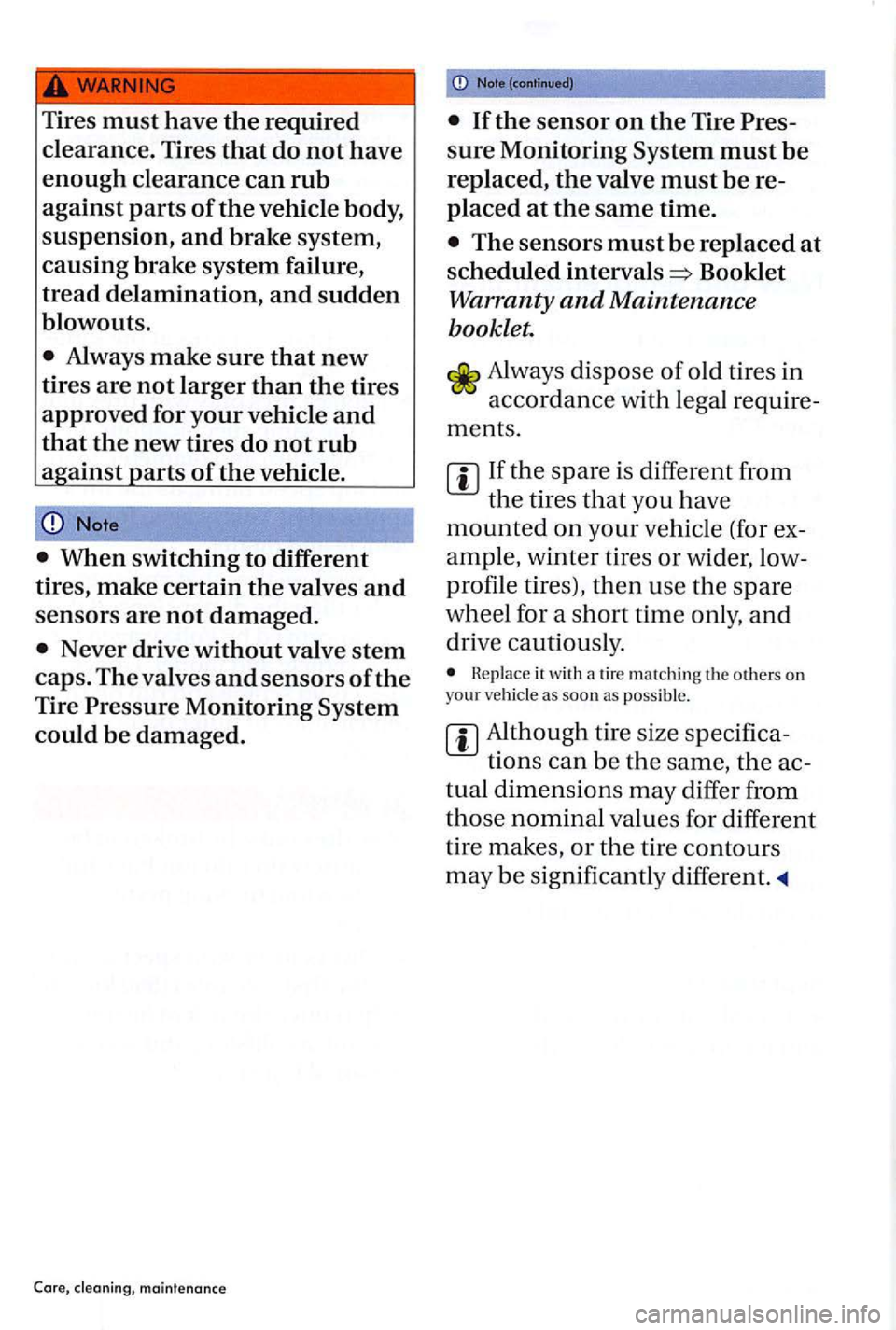
Tires must have the required
clearance. Tires
that do not have
enough clearance can rub
against parts of the vehicle body,
suspension,
and brake system,
causing brake system failure,
tread delamination, and sudden
blowouts.
Note
Never drive without valve stem
caps. The valves and sensors of the
Tire Pressure Monitoring
could be damaged.
Care, maintenance
(continued)
The sensors must be replaced at
scheduled intervals Booklet
Warranty and Maintenance
booklet.
Always dispose of old tires in
accordance with l
egal require
ments.
Replace it a tir e matchin g th e others on your ve hicle as soon as possible.
Although tire siz e specifica-
tions
can be the same, the ac
tual dimension s may differ from
those nominal values for different
tir e makes,
or the tire contours
may be significantly different.
Page 280 of 541

Tire
first read and note the
introduc to ry in
formation
a
nd h ee d the WARNINGS on
page 276.
T he c orr ec t tir e infl atio n
pressure
f o r f ac
tory-install ed tires is lis te d
o n a la b el a
nd a ppli es to summer
and wint er tir es. T he la b el
fig. 161 is on the dri ver door
pillar
Chec k tir e infl ati on pressure
r eg ula
rly a nd on cold tires . C heck
al l
the tir es, includin g th e s pare. In
co l
der clim ates tire pressure
s h ould be c hec k
ed more o ften , but
only w hen th e tir es are c old . Al
w ays use an a cc
urate tir e pressure
ga uge .
Afte r adju stin g tl1e tire inflation
pressures, make sure th at the valve
ca ps a re i
nsta ll ed and please read
informati on and m essages about
programming/rese ttin g th e Tir e
282
Page 281 of 541
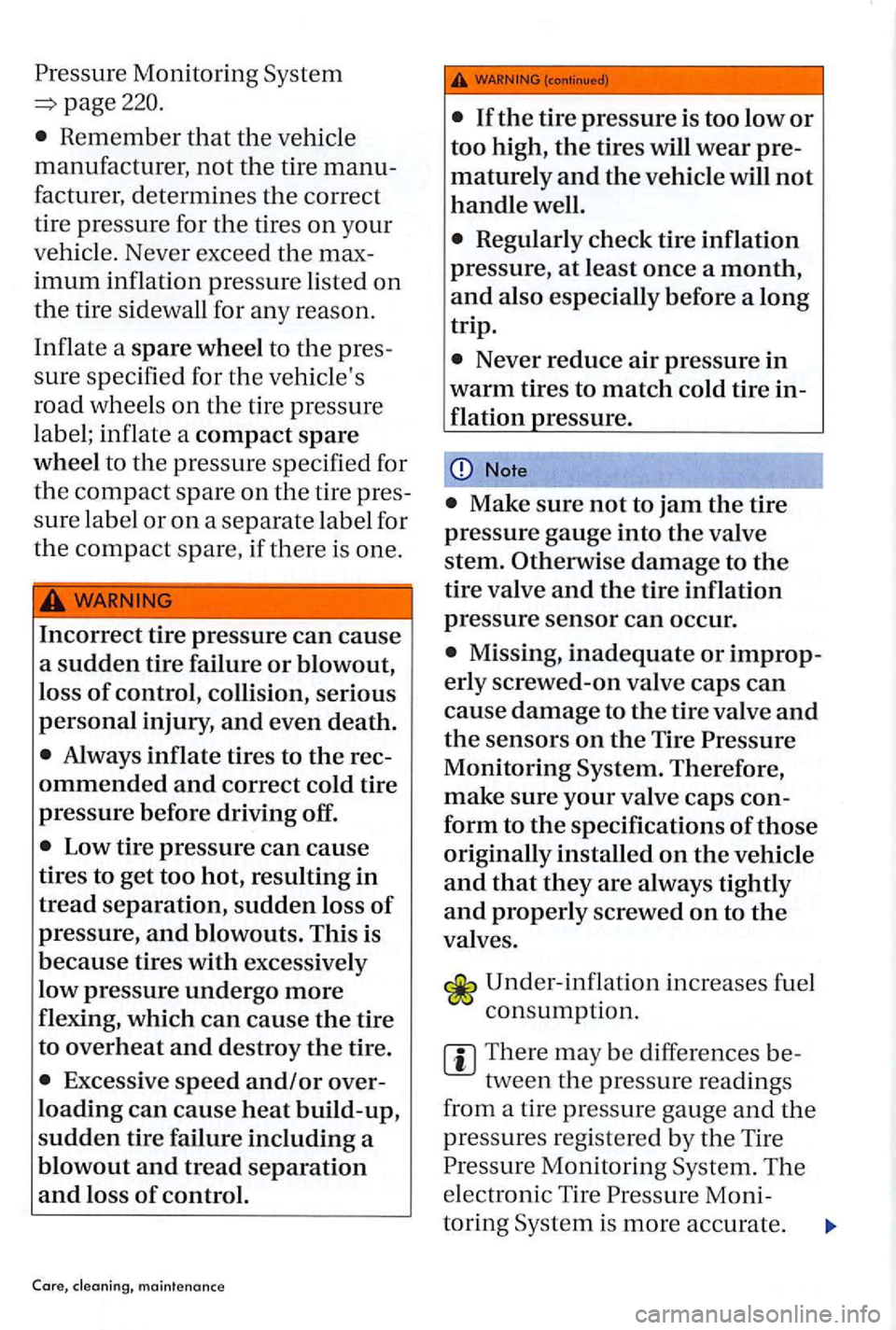
page220.
Remember that the vehi cle
manufacturer, not the tire manu
facturer, determines the correct
tire
pressu re for the tires on your
ve hicl
e. Never exceed the max
imum inflation pressure listed on
the tire s idewa ll for any reaso n.
Inflat e a
spare wheel to the pres
sure specif i
ed for the vehicle's
road whee ls
on the tire pressure
label; inflate a
compact spare
wheel to the pressure specified for
the compact spare on the tire pres
sure label
or on a separate label for
the compact spare, if there is one.
Incorrect tire pressure can cause
a
sudden tire failure or blowout,
loss
of control, collision, serious
personal injury, and even death.
Always inflate tires to the rec
ommended and correct cold tire
pressure before driving off.
Excessive speed and/or over
loading
can cause heat build-up ,
sudden tire failure including a
blowout
and tread separation
and loss of control.
maintenance
If the tire pressure is too low or
too high, the tires will wear pre
maturely and the vehicle will not
handle well.
Regularly check tire inflation
pressure, at least once a month,
and also especially before a long
trip.
Note
increases fuel
There may be differences be-
tween the pressure readings
from a tire pressure gauge
and the
pressures registered by the Tir e
Monitoring System. The
e lec tronic Tire
Moni-
toring System
is more accurate .
Page 282 of 541
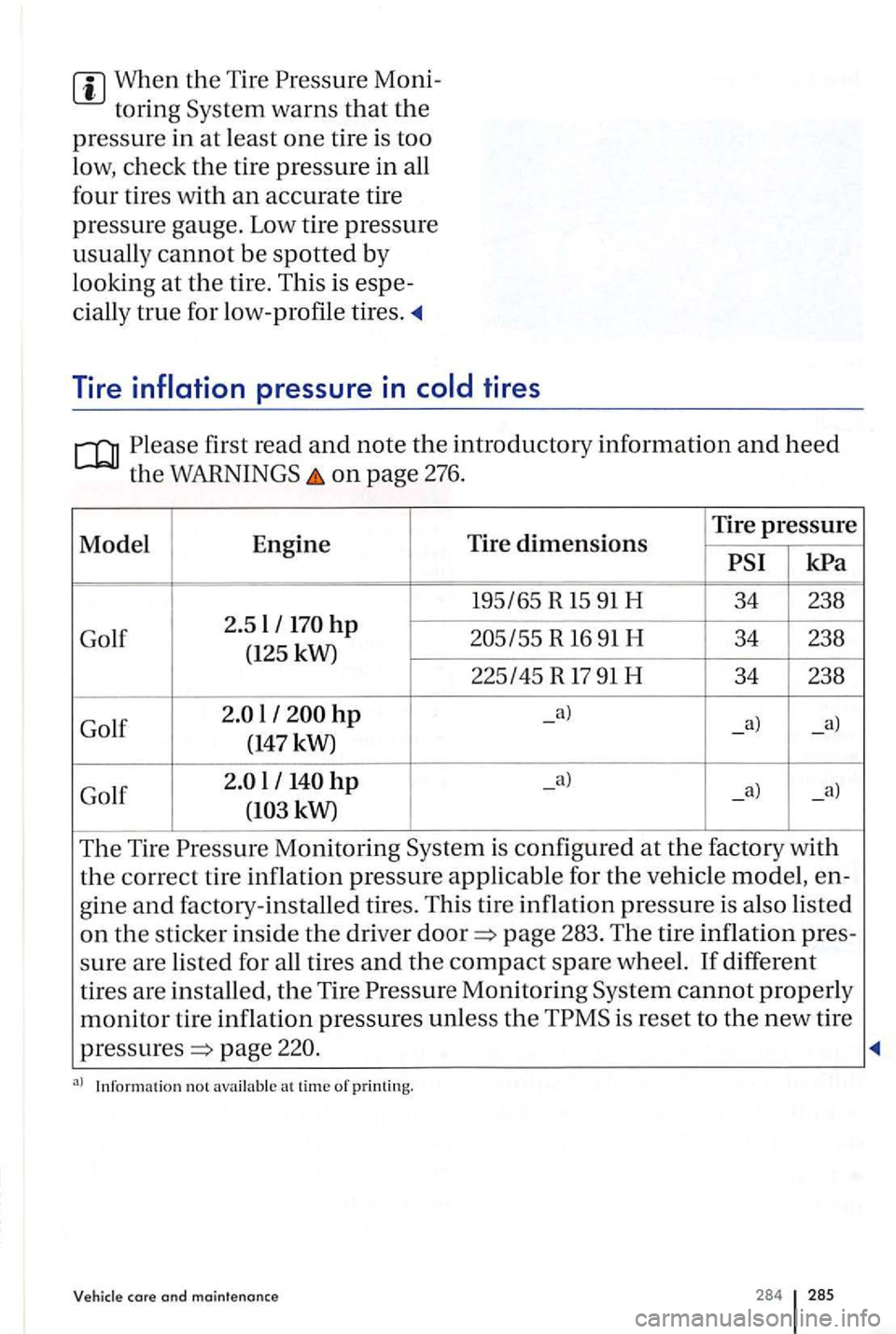
When the Tire
first read and note the introductory information and heed
the on page 276.
Model Engine Tire dimensions Tire pressure
R 16 91 H 34 238
(125 kW)
225145 R
17 91 H 34 238
Golf
l -
The Tire is confi gured at the factory with
the correct tir e inflation pressure applicabl e for the ve hicl e model, en-
g in e
and factory-install ed tire s. This t ire inflation pressure is also listed
on the sticke r insid e the driver page 283 . The tire inflation pres -
s
ure a re listed for all tires and the compact spare wheel. If diff ere n t
tires are
installed, the Tire Monitoring cannot properly
monitor tir e inflation pressures unl ess the is reset to the new tire
page
Informatio n n ot availa b le at t ime o f printing.
Vehicle core and maintenance 284 285
Page 285 of 541
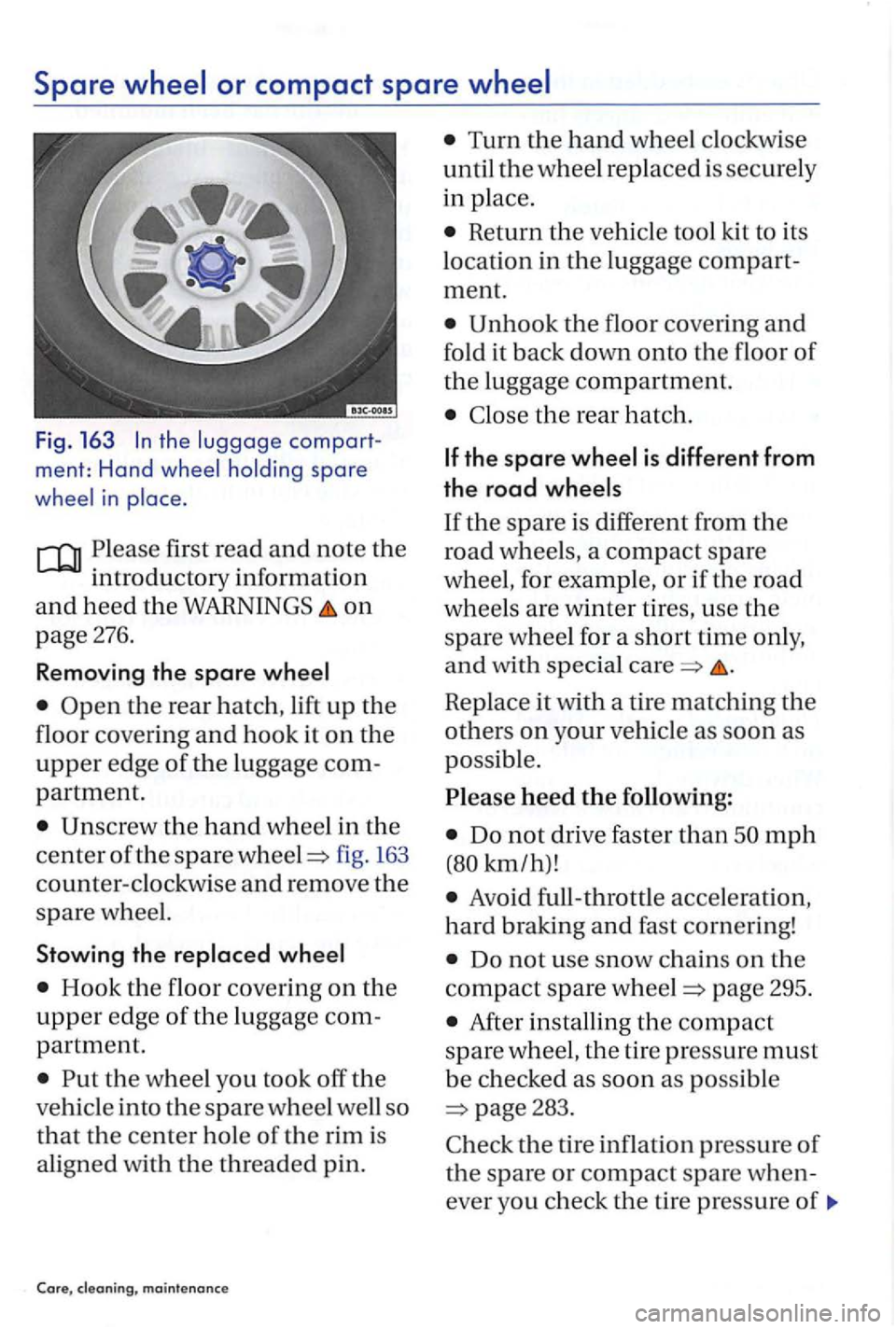
Spare
the compart
ment: Hand
Please first read and note the
introductory information
and heed the WARNINGS on
page 276.
Removing the spare
fig . 163
counter-clockwise and remove the
spare wheel.
Stowing the replaced wheel
Hook the floor cover ing on the
upper edge of the luggage com
partment.
Turn the hand wheel clockwise
until
the wheel replaced is securel y
in place .
Return the vehicle tool kit to its
location in
the luggage compart
ment.
the floor covering and
fold it back down onto the floor of
the luggage compartment.
Close the rear hatch.
Rep lace it with a tire matching the
others on your vehicle as soo n as
poss ible.
Please heed the following:
Do not drive faster than mph
km/h)!
Avoid full-throttle acceleration,
hard braking and fast cornering!
Do not use snow chains on the
compact spare whee l page 295.
After installing the compact
spare wheel, the tire pressure must
b e checked as soon as possib le
283.
Check
the tire inflation pressure of
the spare or compact spare when
ever you ch eck
the tire pressure of
Page 286 of 541
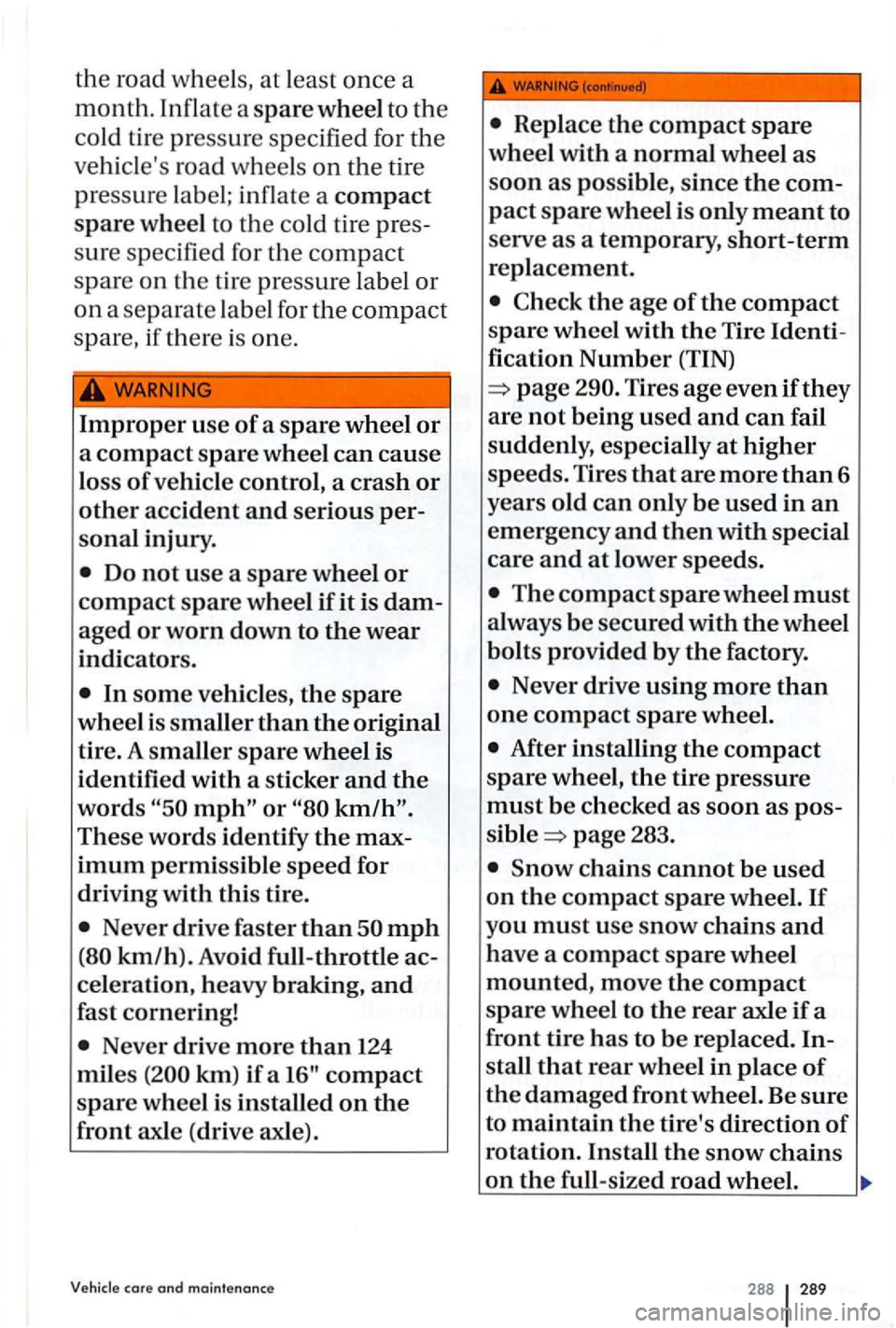
the road wheels , at le a st once a
month. Inflat e a spare wheel to the
cold tire pressure s pecified for the
vehicl e's roa d whee ls on the tir e
press ure la b el; inflat e a compact
spare wheel to the cold tire pres
s
ure s peci fie d for the compact
spare on the tir e pressure label or
on a separate lab el for the compact
spare, if th ere is one .
Improper use of a spare wheel or
a compact spare wheel can cause
loss of vehicle control, a crash or
other accident and serious per
sonal injury.
These words identify the max
imum permissible speed for
driving
with this tire.
Never drive faster than mph
km/h). Avoid full-throttle ac
celeration, heavy braking,
and
fast cornering!
Never drive more than 124
miles km) if a
the age of the compact
spare wheel with the Tire Identi
fication
Number (TIN)
page
The compact spare wheel must
always be secured with the wheel
bolts provided by the factory.
Never drive using more than
one compact spare wheel.
After installing the compact
spare wheel, the tire pressure
must be checked as soon as pos
sible page 283.
288 289